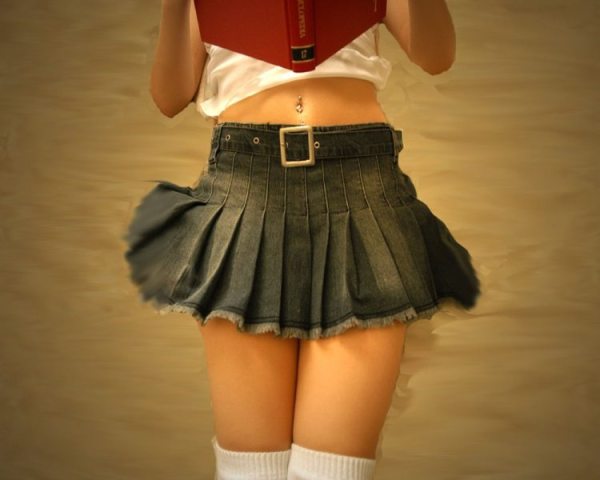The little item of clothing, mini skirt has set out a trend for youth in the modern world. Read on to explore interesting & amazing information on the history, origin & background of mini skirts.
History Of Mini Skirt
A mini skirt is a skirt whose hemline is way above the knee, usually 20 to 30 cm above knee-level. The length is no longer than 10 cm below the buttocks. The development of a mini skirt, which became a defining fashion symbol of “Swinging London” in the 1960s, is credited to the fashion designer Mary Quant. This small and sexy piece of fabric has embodied some of the most fascinating paradoxes of the ancient times, as it suggested empowerment and vulnerability, independence and a desire to please, an attempt to cover and to reveal, maturity and playfulness, liberation and exploitation - at the same time. Condemned and loved simultaneously, the miniskirt exploded into political landscape as well and attracted attention from both men and women. Read on to know more interesting and amazing information on the history of mini skirt.

Image: daily sunny@flickr
Interesting & Amazing Information On Origin & Background Of Mini Skirts
Although mini skirt is known to have existed for as long as the civilization, it gained powerful political and cultural implications only recently. One of the known style pioneers of London, Mary Quant introduced patterned tights and the concept of high street fashion boutique in the world, apart from the mini skirt. She ran a popular clothes shop called ‘Bazaar’ on Kings Road, Chelsea, London, where she marketed and sold her own designs, in the late 1950s. Mini skirt was the result of her experimentation with short skirts. In 1965, after the introduction of mini skirt in the market, it spread beyond a simple street fashion into a major international trend.
Andr Courrges further developed the mini skirts and incorporated them into his mod look for Spring/ Summer Collection 1965. They were worn with white “Courrges boots”, as they were less body hugging. Soon, they became a trademark and gained a greater degree of respectability from the usual street fashion. In the late 1960s, the mini skirt further developed into an even shorter micro skirt. Tights and panty hose replaced stockings rapidly, as the rise in hemlines meant that stocking tops would be visible. Soon, minis were seen on whosoever could pull them off on their bodies. The normal mini skirt was 4 to 5 inches above the knee in New York; while in Swinging London, it could go 7 to 8 inches above knee.
The mid-1970s saw a drastic change in the fashion industry, which returned to longer skirts, such as the midi and the maxi. Two reasons were cited for the same by journalist Christopher Booker: firstly, “there was almost nowhere else to go...the mini-skirts could go no higher” and secondly, “dressed up in mini-skirts and shiny PVC macs, given such impersonal names as 'dolly birds', girls had been transformed into throwaway plastic objects”. The mini skirt that was regarded as a symbol of liberation in the 1960s was worn by some women in the 1970s also, but they were not in a majority. For instance, it was worn by Germaine Greer and Gloria Steinem who thus, came to be known for the promotion of women’s issues.
The mini skirts re-emerged in the 1980s, in the form of “rah-rahs”. They were usually worn by female cheerleaders at sporting and other events. The “puffball” skirts gained short-term popularity in the mid-1980s. They were sported by several women around that time, not to forget, the Princess of Wales and singers Pepsi and Shirlie. With time, the mini skirt was incorporated as business attire and its popularity grew through the entire century. The mid-1990s revealed how common the mini skirt had become through the films and television series that has been made around that time, some of the most popular ones being ‘Friends’, ‘Sex and the City’ and ‘Ally McBeal’.
Hipster trousers became highly fashionable around the turn of the 21st century. With this, the mini skirt developed further, into an even less substantial belt-skirt that represented the idea of covering anything substantial. However, the belt-skirt was rarely worn in public, due to its highly revealing nature. With time, the younger generation could be seen wearing mini skirts over trousers or jeans or with leggings that provide proper coverage to legs. In London, mini skirts became more widespread during the hot summer in 2006 and continued throughout the mild autumn and winter and into the following summer as well. Today, the mini skirts can be commonly seen worn by the younger generations.
See also
More from iloveindia.com
- Home Remedies | Ayurveda | Vastu | Yoga | Feng Shui | Tattoos | Fitness | Garden | Nutrition | Parenting | Bikes | Cars | Baby Care | Indian Weddings | Festivals | Party ideas | Horoscope 2015 | Pets | Finance | Figures of Speech | Hotels in India : Delhi | Hyderabad | Chennai | Mumbai | Kolkata | Bangalore | Ahmedabad | Jaipur
- Contact Us Careers Disclaimer Privacy Policy Advertise With Us Lifestyle Sitemap Copyright iloveindia.com. All Rights Reserved.







